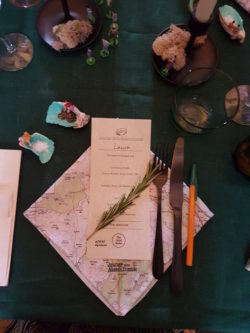Food, our memories and bringing the dead back to life

Dinner with the Grief Series: a meal to remember absent friends, 2nd June 2018
We know that the smell and taste of a slice of gingerbread, a tangy curry, or a sip of homebrew can take us back to a particular moment in our past like almost nothing else. Our senses, of smell particularly, and taste too, make food one of the most evocative ways of recalling past experiences – and people. The food we eat is steeped in emotion – and can be a really powerful way of remembering someone who had died.
Whether that person loved to cook or loved to eat, the food we shared with them is so important. My research, into individuals’ and families’ ways of remembering their loved ones, throws up numerous examples of this. Perhaps one of the most entertaining examples is that of Peter, who in his family history ‘Won’t Someone Remember the Knowles Family of Knostrop?’ tells the story of his Aunt Annie and her elderflower champagne. He remembers ‘It was Annie who had the recipe for elderflower Champagne. I still have that recipe today and brew a batch in June when the elderflowers are in full bloom.’ He includes an image of the very recipe in his printed, unpublished family history, adding that it ‘is a bit worse for wear, I’m afraid’. He tells us how Annie used to store the champagne in her pantry in old Tizer bottles, in which the pressure would build inside… And so there was an element of danger in dealing with them, as ‘they would sometimes explode like bombs going off’. Peter in turn ‘still religiously make[s] elderflower champagne every June when the elderflowers are still in bloom’. The taste of the champagne, the ritual of making it, having the original recipe, and reprinting it in his family history are all part of Peter’s remembrance of his Aunt Annie.
For Elin, a refugee originally from Estonia, who came to Leeds after the Second World War, food was inextricably tied up with the memories of her grandmother and her Estonian heritage. The whole book is something of a tribute to her grandmother, and starts with a description of her death, later on, before going back to Elin’s childhood in 1930s and 1940s Estonia. When Elin was put in Headingley orphanage because of the strict regulations of her mother and grandmother’s work as displaced persons, she saw them only rarely, and recalls their reunion when she was first allowed to visit them. Her grandmother’s care for her is orientated around feeding her, and she remembers her grandmother telling her,
‘“You need to eat more oatmeal. Thank God we can feed you again.” With these words she went over to the wardrobe and began to rummage among the tins and packages piled in the back. “We now have rye bread, and rollmops (pickled herring in a roll). I made some rosolje (Estonian beet salad). Our Estonian friends gave us a small blood sausage for Christmas. You must be hungry.”’
For Elin, her grandmother’s fondness for certain foods and wanting Elin to eat them are tied up in the way Elin remembers her, and in turn her connection with Estonia through its food.
For Molly, it was the whole ritual of breakfast that reminded her of her grandmother. Living in a Glasgow tenement in the 1940s and 1950s, Molly would be sent for morning rolls (a Scottish institution) and other supplies whilst her Grannie made porridge. When they reunited for breakfast, Molly remembered ‘How cosy these winter breakfasts were, for we had all been out of doors to whet our appetites, the boys delivering their milk round, and of course me getting the messages in. I had thought this routine would go on for ever, for I knew no other. But now Grannie was dead, and here was I in a strange bed in a strange kitchen.’ The ritual of breakfast and the food they ate in their cosy kitchen was what Molly thought of when writing about her Grannie’s death. The tea, porridge and morning rolls they shared each morning provided a way to tell us, as readers, about Grannie, and Molly’s relationship with her.
Food, then, and mealtimes, are important in how we remember those who have died. This is something we’ve been exploring as part of our collaboration with Ellie Harrison and the Grief Series. Through a Journey with Absent Friends, we’re exploring with them the ways in which places play a part in our practices of remembrance. The journey is punctuated with meals to celebrate the lives of those we’ve lost, and through these events we’ll be thinking about how food matters in our memories.
Which foods bring back memories for you? We would love to hear more examples of this, from Yorkshire pudding to rice and peas, add your food memories below.
